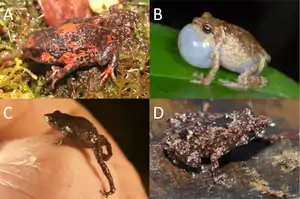Choerophryne
Choerophryne ist eine Amphibien-Gattung aus der Unterfamilie der Papua-Engmaulfrösche.
| Choerophryne | ||||||||||||
|---|---|---|---|---|---|---|---|---|---|---|---|---|

Verschiedene Arten der Gattung Choerophryne | ||||||||||||
| Systematik | ||||||||||||
| ||||||||||||
| Wissenschaftlicher Name | ||||||||||||
| Choerophryne | ||||||||||||
| Van Kampen, 1914 |
Beschreibung
Die Pupillen sind horizontal. Die Zunge ist klein, länglich, hinten schwach eingeschnitten und hinten und an den Seiten frei abhebbar. Gaumenzähne und -leisten fehlen. Es sind zwei gezähnelte Gaumenfalten vorhanden. Das Trommelfell ist deutlich erkennbar. Die Finger und Zehen besitzen große Haftscheiben. Die Endphalangen sind knöchern und T-förmig. Zwischen den Metatarsen der 4. und 5. Zehe befindet sich keine Schwimmhaut. Praecoracoide und Claviculae fehlen.[1]
Systematik
Die Gattung Choerophryne wurde 1914 von Pieter Nicolaas van Kampen erstbeschrieben. 18 Arten der Gattung Albericus Burton & Zweifel, 1995 wurde 2015 mit der Gattung Choerophryne zusammengelegt. Molekulargenetische Untersuchungen hatten eine Paraphylie der beiden Gattungen ergeben.[3] Zusammen mit 2 im Jahr 2015 neu beschriebenen Arten, 3 im Jahr 2017 beschriebenen Arten und 2 Arten aus dem Jahr 2018 umfasst die Gattung 36 Arten:[2]
Stand: 4. Juli 2018
- Choerophryne allisoni Richards and Burton, 2003
- Choerophryne alpestris (Kraus, 2010)
- Choerophryne amomani Günther, 2008
- Choerophryne arndtorum Günther, 2008
- Choerophryne bickfordi Kraus, 2018[4]
- Choerophryne bisyllaba Günther & Richards, 2017[5]
- Choerophryne brevicrus (Günther & Richards, 2012)
- Choerophryne brunhildae (Menzies, 1999)
- Choerophryne bryonopsis Kraus, 2013
- Choerophryne burtoni Richards, Dahl & Hiaso, 2007
- Choerophryne crucifer Günther & Richards, 2017[5]
- Choerophryne darlingtoni (Loveridge, 1948)
- Choerophryne exclamitans (Kraus & Allison, 2005)
- Choerophryne fafniri (Menzies, 1999)
- Choerophryne epirrhina Ianella, Richards & Oliver, 2015[6]
- Choerophryne gracilirostris Ianella, Richards & Oliver, 2014[7]
- Choerophryne grylloides Ianella, Richards & Oliver, 2015[6]
- Choerophryne gudrunae (Menzies, 1999)
- Choerophryne gunnari (Menzies, 1999)
- Choerophryne laurini (Günther, 2000)
- Choerophryne longirostris Kraus and Allison, 2001
- Choerophryne microps Günther, 2008
- Choerophryne multisyllaba Günther & Richards, 2017[5]
- Choerophryne murrita (Kraus and Allison, 2009)
- Choerophryne nigrescens Günther, 2008
- Choerophryne pandanicola (Günther & Richards, 2012)
- Choerophryne pipiens Günther, Richards & Tjaturadi, 2018[8]
- Choerophryne proboscidea Van Kampen, 1914
- Choerophryne rhenaurum (Menzies, 1999)
- Choerophryne rostellifer (Wandolleck, 1911)
- Choerophryne sanguinopicta (Kraus and Allison, 2005)
- Choerophryne siegfriedi (Menzies, 1999)
- Choerophryne swanhildae (Menzies, 1999)
- Choerophryne tubercula (Richards, Johnston & Burton, 1992)
- Choerophryne valkuriarum (Menzies, 1999)
- Choerophryne variegata (Van Kampen, 1923)
Die im Jahr 2015 mit der Gattung Choerophryne synonymisierten 18 Arten der Gattung Albericus waren:
- Albericus alpestris
- Albericus brevicrus
- Albericus brunhildae
- Albericus darlingtoni
- Albericus exclamitans
- Albericus fafniri
- Albericus gudrunae
- Albericus gunnari
- Albericus laurini
- Albericus murritus
- Albericus pandanicolus
- Albericus rhenaurum
- Albericus sanguinopictus
- Albericus siegfriedi
- Albericus swanhildae
- Albericus tuberculus
- Albericus valkuriarum
- Albericus variegatus
Einzelnachweise
- Fritz Nieden: Anura II. In: F. E. Schulze, W. Kükenthal, K. Heider (Hrsg.): Das Tierreich. Walter de Gruyter & Co., Berlin und Leipzig 1926, S. 62.
- Darrel R. Frost: Choerophryne Van Kampen, 1914. In: Amphibian Species of the World: an Online Reference. Version 6.0 (abgerufen am 28. Februar 2014). (online).
- Pedro L. V. Peloso, Darrel R. Frost, Stephen J. Richards, Miguel T. Rodrigues, Stephen Donnellan, Masafumi Matsui, Cristopher J. Raxworthy, S.D. Biju, Emily Moriarty Lemmon, Alan R. Lemmon & Ward C. Wheeler: The impact of anchored phylogenomics and taxon sampling on phylogenetic inference in narrow-mouthed frogs (Anura, Microhylidae). Cladistics, 3, 1-28, März 2015 doi:10.1111/cla.12118
- Fred Kraus: A new species of Choerophryne (Anura: Microhylidae) from Papua New Guinea. Proceedings of the Biological Society of Washington, 131:, S. 53–60., 2018
- R. Günther und S. J. Richards: Three new species of the microhylid frog genus Choerophryne (Amphibia, Anura, Microhylidae) from Papua New Guinea. Zoosystematics and Evolution. Museum für Naturkunde Berlin, 93, S. 265–279, 2017
- Amy Iannella, Paul Oliver & Stephen Richards: Two new species of Choerophryne (Anura, Microhylidae) from the northern versant of Papua New Guinea’s central cordillera. Zootaxa, 4058, 3, S. 332–340, Dezember 2015 doi:10.11646/zootaxa.4058.3.2
- Amy Iannella, Paul Oliver & Stephen Richards: A new species of Choerophryne (Anura, Microhylidae) from the central cordillera of Papua New Guinea. Zootaxa, 3753, 5, S. 332–340, Januar 2014 doi:10.11646/zootaxa.3753.5.6
- Rainer Günther, S. J. Richards und Burhan Tjaturadi: Two new frog species from the Foja Mountains in northwestern New Guinea (Amphibia, Anura, Microhylidae). Vertebrate Zoology, 68, S. 109-122, 2018
Literatur
- Van Kampen: Zoologisches Jahrbuch. Abt. Syst., 37, S. 376, Jena 1914 (Erstbeschreibung)
- Fritz Nieden: Anura II. In: F. E. Schulze, W. Kükenthal, K. Heider (Hrsg.): Das Tierreich. Walter de Gruyter & Co., Berlin und Leipzig 1926, S. 62